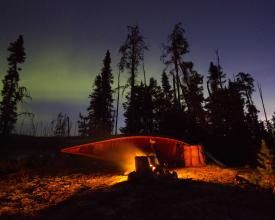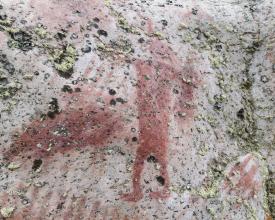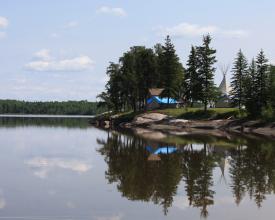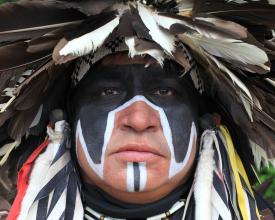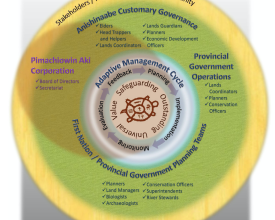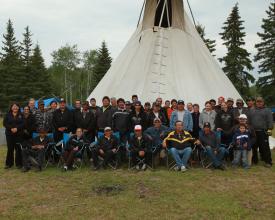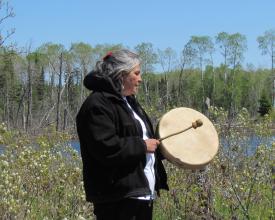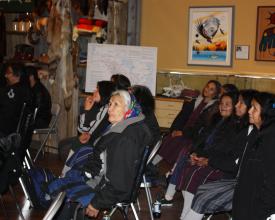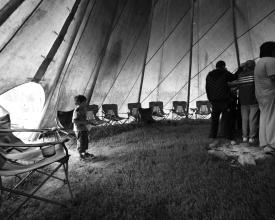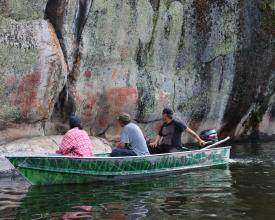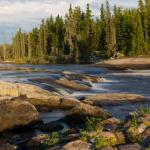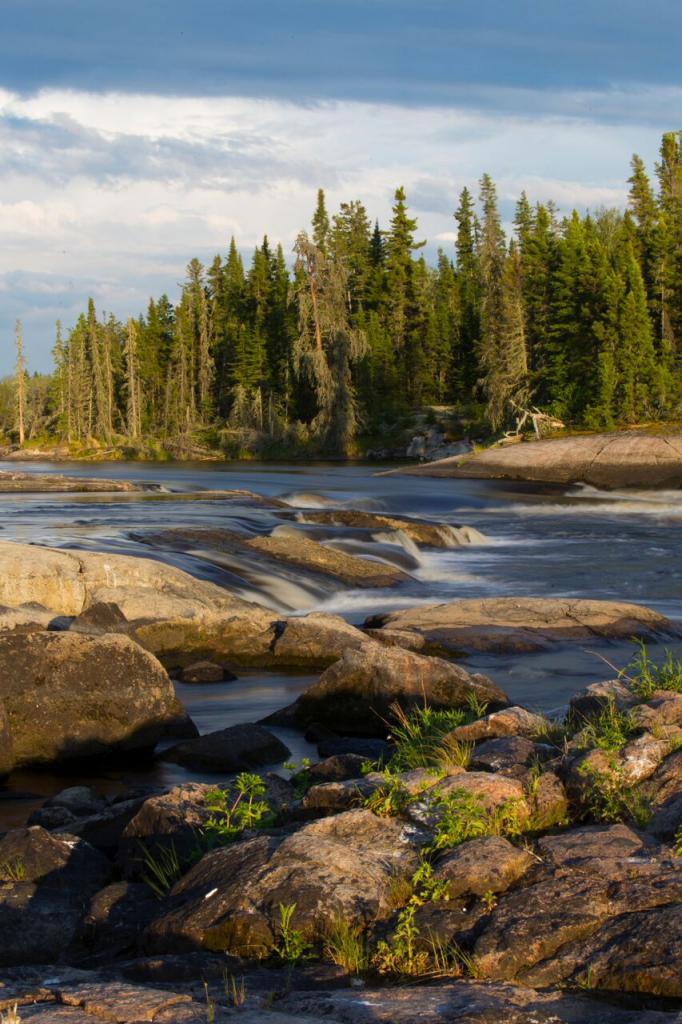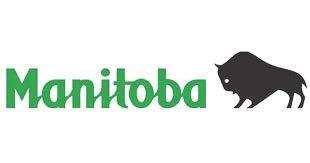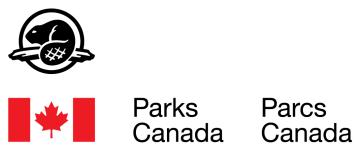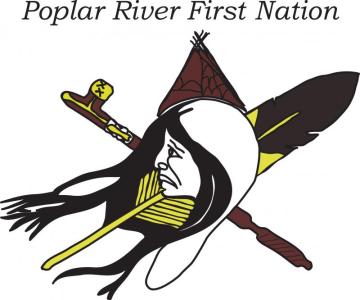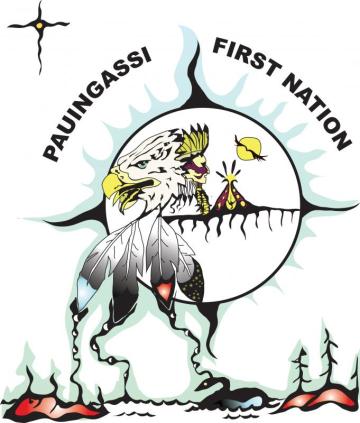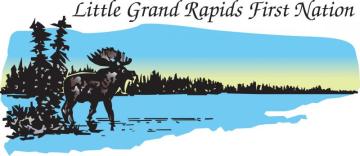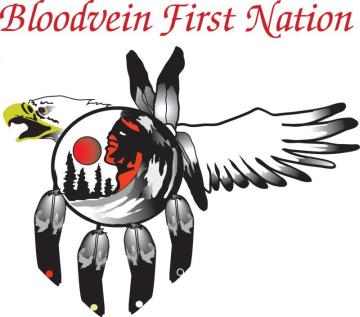
Valoriser les liens entre la nature et la culture dans la planification et la gestion du site du patrimoine mondial de Pimachiowin Aki, Canada
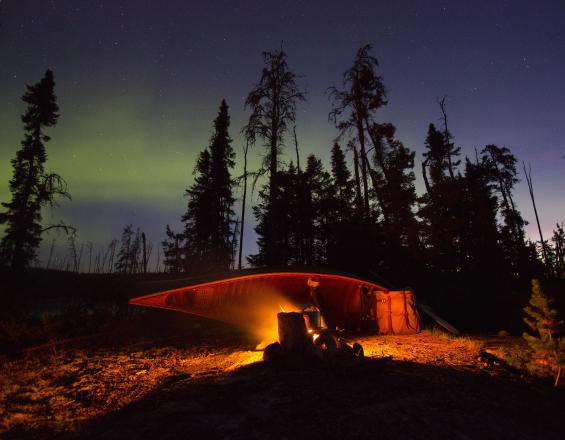
Pimachiowin Aki (la terre qui donne la vie) a été inscrit en 2018 sur la Liste du patrimoine mondial en tant que patrimoine culturel et naturel mixte sur la base des critères (iii), (vi) et (ix). Composé du parc provincial Atikaki, du parc provincial Woodland Caribou, de la réserve de conservation Eagle-Snowshoe et de quatre zones de planification de l'utilisation traditionnelle des Premières Nations, Pimachiowin Aki, est un exemple exceptionnel du biome boréal mondial et un paysage culturel qui témoigne de la tradition de Ji-ganawendamang Gidakiiminaan (Garder la terre). Les Premières nations Anishinaabe ont signé un accord en 2002 pour protéger et entretenir leurs terres ancestrales et leur mode de vie, et pour demander l'inscription du site au patrimoine mondial. En 2006, les Premières nations et les gouvernements provinciaux ont créé la Pimachiowin Aki Corporation, une organisation caritative à but non lucratif chargée de préparer la proposition d'inscription et d'élaborer un plan de gestion selon les principes du respect mutuel et de la collaboration.
Contexte
Défis à relever
Défis sociaux : perte potentielle de l'identité culturelle et de l'Anishinaabemowin (langue ojibwée) ; réalisation de l'unité et du consensus sur la vision de l'avenir, les valeurs, les objectifs de planification et les limites administratives ; capacité de planification ; reconnaissance des connaissances traditionnelles, des croyances et des pratiques de gestion dans les processus de prise de décision.
Défis économiques : pauvreté ; maintien des moyens de subsistance traditionnels ; insécurité alimentaire ; infrastructures communautaires, y compris le logement ; développement et diversification de l'économie locale contribuant au bien-être des communautés.
Défis environnementaux : changement climatique ; état de la surveillance et des rapports sur la conservation ; augmentation de la pression de la chasse et de la pêche ; reconnaissance juridique et respect des plans de gestion des terres et des prescriptions en matière de zonage.
Emplacement
Traiter
Résumé du processus
Pour protéger les terres ancestrales des Anishinaabe, il était fondamental de respecter et d'utiliser un processus de gestion et d'aménagement du territoire fondé sur les connaissances, les croyances et les pratiques des Anishinaabe. Les processus de gestion et d'aménagement du territoire et de nomination au patrimoine mondial ont permis la reconnaissance et la valorisation de ces zones en tant que paysage culturel. La création de la Pimachiowin Aki Corporation (BB1), une société caritative à but non lucratif à laquelle participent les Premières nations et les gouvernements provinciaux, a été essentielle, en particulier pour lancer le processus de proposition d'inscription sur la Liste du patrimoine mondial. Le processus s'appuie sur les conseils continus et réguliers des aînés (BB2), qui guident et accompagnent toujours la gestion et la protection du site. Sur ces bases, l'établissement d'un dialogue sur les systèmes de connaissance (BB3) était nécessaire pour que la gestion et l'aménagement du territoire soient couronnés de succès et répondent aux conditions d'authenticité et d'intégrité ainsi qu'aux exigences de protection et de gestion pour la proposition d'inscription et la gestion continue du site. L'implication des anciens, des jeunes et des femmes (BB4) dans l'ensemble du processus garantit la durabilité de la solution. Le développement d'un système de suivi participatif (BB5) soutient la promotion continue du savoir anishinaabe.
Blocs de construction
Création de la Pimachiowin Aki Corporation : un partenariat à plusieurs niveaux et entre plusieurs parties prenantes
Les Premières nations ont entamé un processus de définition des terres ancestrales en réalisant des études sur l'utilisation et l'occupation des terres, des recherches archéologiques, des études sur l'habitat de l'élan, de la documentation historique et des plans de gestion des terres à l'échelle communautaire. À partir de 1999, elles ont entamé un dialogue sur l'importance des terres ancestrales, le mode de vie, les menaces industrielles et la manière dont elles pouvaient travailler ensemble et s'entraider. En 2002, l'accord des Premières nations a été signé, un document historique décrivant l'engagement à travailler ensemble pour protéger les terres ancestrales. La création d'une société de bienfaisance à but non lucratif dotée d'un conseil d'administration a été motivée par la volonté de disposer d'un forum pour un dialogue continu et régulier, d'un processus décisionnel consensuel et non hiérarchique et d'une entité juridique capable de conclure des contrats, de collecter des fonds et d'élaborer un dossier de proposition d'inscription sur la Liste du patrimoine mondial. La société a été créée en 2006 avec un conseil d'administration composé d'un représentant de chaque Première nation et du gouvernement provincial. Un directeur exécutif supervise les opérations et apporte son soutien et ses conseils. La mission est de reconnaître et de soutenir la culture anishinaabe et de sauvegarder la forêt boréale, en préservant un paysage culturel vivant pour assurer le bien-être des Anishinaabeg et pour le bénéfice et la jouissance de tous les peuples.
Facteurs favorables
- Accord des Premières nations signé en 2002 pour collaborer à la protection des terres ancestrales.
- Protocole d'accord sur les réserves intégrales interprovinciales (Manitoba et Ontario) signé en 1998 pour collaborer à la planification et à la gestion des parcs provinciaux adjacents.
- Appel de l'UICN pour des nominations au patrimoine mondial sur les écosystèmes du bouclier boréal en 2003.
- Volonté des gouvernements du Manitoba et de l'Ontario et des quatre Premières nations Pimachiowin Aki de travailler ensemble sur une proposition d'inscription.
- Mise à disposition de fonds par les provinces pour créer la Pimachiowin Aki Corporation.
Leçon apprise
- Nécessité de niveaux de soutien prévisibles - pas seulement des subventions gouvernementales annuelles - pour contribuer à la viabilité financière et à une plus grande fidélisation du personnel.
- Importance de la planification stratégique et du développement du leadership.
- Nécessité de renforcer la capacité de l'organisation à tirer parti du capital financier et humain, d'améliorer la gestion des subventions, de permettre des évaluations à plus long terme, de renforcer les programmes et d'atteindre les donateurs qui souhaitent contribuer à la mise en place d'un programme.
- Assurer un engagement/une participation large et fréquente de tous les partenaires dans la définition de la vision, de la mission, des objectifs caritatifs et des fonctions des administrateurs.
- La réussite de l'association ne tient pas seulement au fait que certaines procédures sont en place pour canaliser l'information et la communication, mais aussi au fait qu'elle favorise une culture qui valorise l'apprentissage mutuel et recommande des moyens de renforcer les capacités et de créer des opportunités dans des domaines où il existe actuellement des difficultés.
Honorer la sagesse, la vision et les enseignements (ki ki no mah gay win) des anciens pour guider l'utilisation de la terre et les relations respectueuses entre eux et avec la terre.
Les anciens et les autres personnes ayant des connaissances sur la terre(ki ki no mah gay win) sont importants pour leur rôle dans la prise de décision sur les questions personnelles, familiales et communautaires liées à l'utilisation de la terre. Les aînés bien informés sont respectés pour leur rôle dans la continuité de Ji-ganawendamang Gidakiiminaan (conservation de la terre). Les anciens ont plaidé pour que la voix de la communauté soit entendue dans la définition de l'orientation stratégique des terres ancestrales, dans le dossier de nomination et dans toutes les communications et décisions relatives à Pimachiowin Aki. Les aînés participent aux assemblées générales annuelles, aux réunions ordinaires et extraordinaires de la Corporation, aux réunions de l'équipe de planification et aux réunions du groupe de travail sur les terres communautaires, afin d'orienter la protection et la gestion de Pimachiowin Aki conformément aux principes de Ji-ganawendamang Gidakiiminaan. L'adhésion à ces principes requiert l'autorité de la communauté locale en matière de protection et de gestion, ainsi qu'une présence continue sur le territoire. Les personnes qui ont le plus d'expérience sur le terrain (par exemple, les aînés, les trappeurs en chef, les assistants sur les terrains de trappage et d'autres personnes ayant des liens personnels et familiaux avec des zones de récolte familiales spécifiques) sont les chefs de file du partage de l'Akiiwi-gikendamowining et du respect des principes du Ji-ganawendamang Gidakiiminaan.
Facteurs favorables
- Accord avec les Premières Nations.
- Rédaction du dossier de candidature.
- Forum des anciens et des jeunes.
- Volonté des aînés de partager leurs connaissances avec le reste du monde.
- Processus mené par la communauté et dirigé par les aînés.
- Volonté des aînés de consacrer leur temps et leur énergie à participer à des réunions à l'extérieur des communautés pour s'assurer que leur voix est entendue et comprise.
- Réunions des groupes de travail communautaires sur les terres.
Leçon apprise
- Patience dans la planification de la gestion des terres et les processus de nomination afin de s'assurer que les aînés sont impliqués tôt et souvent.
- Tenir compte des impératifs politiques, mais ne pas les laisser dicter le calendrier et les échéances.
- Les nominations menées par les autochtones ou toute autre initiative doivent tenir compte du savoir et de la voix des aînés à tous les stades.
Instaurer un dialogue sur les systèmes de connaissances entre les populations autochtones et les scientifiques occidentaux dans le cadre de la gestion et de l'aménagement du territoire
Le système de connaissances des Anishinaabe, transmis et partagé par les aînés, a toujours guidé la vie de la communauté et les décisions concernant les terres. Dans le cadre de l'accord des Premières nations, de la gestion et de la planification des terres et des processus de nomination au patrimoine mondial, les gardiens du savoir des Premières nations Pimachiowin Aki ont commencé à travailler avec des scientifiques qui ajoutaient leur système de connaissances aux plans des zones traditionnelles et à la nomination. Le seul moyen de réussir était d'instaurer un dialogue régulier entre les deux systèmes de connaissances et l'engagement, au niveau de la communauté, des anciens et des autres gardiens du savoir, afin de s'assurer que la voix de la communauté était entendue et documentée dans les plans, le dossier de proposition d'inscription et dans toutes les communications, par le biais des réunions du groupe de travail communautaire sur les terres, des réunions de la Pimachiowin Aki Corporation et des réunions des représentants des Premières nations et du gouvernement au sein des équipes de planification de la gestion des terres et de mise en œuvre des plans. Les gardiens du savoir de la communauté et les scientifiques ont appris à se comprendre. Ce fut un long processus et, grâce au respect mutuel et à la patience, nous avons pu nous mettre d'accord sur les informations fournies dans les documents. Ce processus est toujours en place aujourd'hui, avec l'engagement des communautés lorsque les gouvernements provinciaux, les universités et les organisations mènent des projets de recherche à Pimachiowin Aki.
Facteurs favorables
- Reconnaissance de la validité des systèmes de connaissances et de croyances anishinaabe et des droits des Premières nations à s'exprimer sur les terres ancestrales.
- Dialogue respectueux et volonté des participants des deux systèmes de se comprendre mutuellement.
- Le financement des réunions communautaires régulières est assuré par les deux gouvernements provinciaux, les gouvernements des Premières nations contribuant également au financement.
Leçon apprise
- Engager les populations qui vivent dans les zones protégées dans un dialogue constructif et des processus de prise de décision sur les valeurs, l'histoire et l'avenir de ces zones, et les éduquer à la co-génération des connaissances, par opposition à l'intégration de la sagesse et des traditions culturelles dans les politiques, les pratiques de durabilité et les plans de gestion existants.
- Veiller à ce que les systèmes de connaissances scientifiques et anishinaabe fonctionnent main dans la main ; il faut du temps et beaucoup de travail pour établir une bonne relation de travail.
- Faire preuve d'ouverture d'esprit et apprendre les uns des autres dans un environnement interculturel.
- La planification de la gestion des terres pour définir et reconnaître les visions, les objectifs et les priorités des communautés des Premières nations est l'un des fondements de la proposition d'inscription d'un site au patrimoine mondial.
- La pleine participation des gardiens du savoir anishinaabe est une exigence pour toute recherche potentielle dans le site du patrimoine mondial de Pimachiowin Aki.
Approches intergénérationnelles et inclusives de la participation au dialogue des communautés
Les voix et les points de vue des jeunes doivent être reconnus au même titre que ceux des adultes et des aînés afin de garantir que l'ensemble de la communauté participe au dialogue. Les jeunes ont participé à l'élaboration des plans de gestion des terres communautaires et du dossier de candidature de Pimachiowin Aki. Nous aurons besoin des jeunes pour comprendre et poursuivre ce travail après le départ des aînés. Pour ce faire, des présentations et des séances de dialogue avec les aînés ont eu lieu dans les écoles communautaires et les forums de jeunes. Les communautés organisent régulièrement des camps d'enseignement de la langue, des connaissances et des terres anishinaabe pour les aînés et les jeunes afin de s'assurer que les enfants et les jeunes comprennent l'importance de la terre et continuent à soutenir ce travail à l'avenir. Ces camps ont lieu à l'extérieur des communautés, tout au long de l'été.
Parallèlement, Pimachiowin Aki Corporation a organisé deux forums régionaux de femmes : le forum des femmes de Pimachiowin Aki, le 18 janvier 2017, et l'Ikwewak Gikendasowinan, le 23 janvier 2018, où des aînées et des jeunes femmes ont participé à la formulation de recommandations aux partenaires de Pimachiowin Aki, qui ont été incluses dans le dossier de nomination. La participation continue et le leadership des femmes dans la gouvernance est une caractéristique importante du cadre de gestion du site.
Facteurs favorables
- Reconnaître l'importance de faciliter les interactions entre les aînés et les jeunes pour préserver le mode de vie et la langue des Anishinaabe, le paysage du bouclier boréal et l'interdépendance de la culture et de la nature .
- Fonds pour faciliter les réunions des groupes de travail communautaires sur les terres et les possibilités d'apprentissage sur les terres.
Leçon apprise
- Faciliter la participation des jeunes et des femmes dès le début est essentiel pour réussir. Le dialogue entre les aînés et les jeunes est essentiel pour que les efforts déployés par les communautés pour protéger les terres ancestrales et le Pimachiowin Aki soient couronnés de succès, aujourd'hui et à l'avenir. Cependant, au cours des processus de gestion, de planification et de nomination des terres, lorsque nous avions des contraintes de temps ou de budget, nous avons parfois laissé de côté l'engagement des jeunes. C'était une erreur, et nous nous efforçons maintenant de mettre l'accent sur l'engagement des jeunes.
- La société soutient en permanence les possibilités d'expérience offertes aux jeunes dans le cadre d'activités terrestres ciblées, en insistant sur le fait qu'un comportement respectueux est nécessaire à la survie, et veille à ce que les écoles locales et régionales reçoivent des informations et des ressources leur permettant d'intégrer dans leurs programmes les valeurs culturelles, naturelles et éducatives représentées par Pimachiowin Aki.
- Le programme des gardiens des Premières nations de Pimachiowin Aki veille à ce que le dialogue intergénérationnel se poursuive.
Mise en place d'un système participatif de suivi et de rapport sur l'état de conservation du site du patrimoine mondial
Les Premières nations Pimachiowin Aki et la Pimachiowin Aki Corporation ont élaboré un programme de gardiens en 2016 pour mettre en œuvre l'orientation stratégique définie dans les plans de gestion approuvés, à savoir assurer le bien-être de la communauté, collecter des fonds, soutenir le développement économique local, créer des opportunités pour les aînés et les jeunes de travailler ensemble, maintenir/améliorer notre tradition culturelle et assurer la conformité avec les lois et politiques coutumières. Les membres de la communauté ont acquis des capacités et des compétences en matière de communication, de tenue de registres, de survie, de bonne santé et d'utilisation du GPS pour collecter et enregistrer des informations géographiques. Les gardiens sont des membres de la communauté qui observent, enregistrent et rendent compte de la santé des écosystèmes et des sites culturels, éduquent le public sur la façon d'être de bons intendants du paysage culturel, travaillent avec les gestionnaires des terres et des ressources du gouvernement provincial et conservent les pictogrammes, les pétroformes, les sites archéologiques, les sites culturels et les valeurs immatérielles qui façonnent les liens entre les Anishinaabe et le site, y compris les traditions orales essentielles à l'expression et à la transmission intergénérationnelle de l'Akiiwi-gikendamowining (connaissances fondées sur la terre), les lois coutumières et les noms géographiques.
Facteurs favorables
- Financement (salaires et frais de fonctionnement des tuteurs, honoraires des aînés, ateliers et formations).
- Un leadership fort au niveau de la communauté.
- Connaissance des indicateurs des valeurs sociales, économiques, culturelles et environnementales du site.
- Bonnes relations avec les dirigeants, les membres de la communauté, les scientifiques occidentaux modernes et les gestionnaires des terres du gouvernement (respect mutuel, confiance, honnêteté, parité dans la prise de décision).
- Possibilités de partager des expériences avec d'autres programmes de gardiennage et d'intendance.
Leçon apprise
- Le succès du programme des tuteurs dépend du maintien de leur emploi à plein temps et du maintien des liens entre les tuteurs, les aînés et les jeunes.
- Les initiatives des tuteurs risquent d'échouer complètement ou de produire des résultats décevants si une planification minutieuse n'est pas effectuée avant le début des activités de suivi. Pour que le suivi soit réussi, les données et les informations doivent être stockées, organisées et distribuées de manière à garantir leur utilité, à maintenir leur qualité et leur crédibilité, et à protéger les informations confidentielles.
- Les inventaires et les bases de données compilés sur la base d'un SIG (système d'information géographique) sont le meilleur moyen d'identifier les lacunes en matière de données, qui peuvent ensuite être utilisées pour mettre à jour les priorités et les plans de surveillance. Un cadre de suivi et un système de gestion de l'information fournissent des informations essentielles pour la gouvernance et la prise de décision.
- Les anciens et les autres gardiens du savoir participent à l'élaboration d'un ensemble plus large d'indicateurs et de mesures afin de fournir une déclaration fiable sur l'état - et les tendances - de la santé de l'écosystème et du paysage culturel.
Impacts
- Un plan de gestion intégré et adaptatif pour le site, unifiant 9 plans de gestion régionaux, intégrant la gouvernance coutumière, les prescriptions légales et les dispositions institutionnelles sur l'ensemble du site du patrimoine mondial afin de sauvegarder l'intégrité, l'authenticité et les attributs qui transmettent sa valeur universelle exceptionnelle.
- Reconnaissance internationale de la tradition culturelle anishinaabe de protection de la nature et de la transmission intergénérationnelle des connaissances, des croyances et des pratiques.
- Renforcement de l'identité culturelle anishinaabe et autonomisation des jeunes et des femmes autochtones.
- Renouvellement et renforcement du dialogue entre les communautés des Premières nations et les gouvernements provinciaux.
- Influence du système du patrimoine mondial sur l'intégration des valeurs naturelles et culturelles dans les processus d'évaluation et sur la reconnaissance des voix et des modes de connaissance des peuples autochtones, conformément au principe du consentement préalable, libre et éclairé.
- Demande de conseils par d'autres États parties à la Convention du patrimoine mondial.
Bénéficiaires
Les Premières nations de la rivière Poplar, de Pauingassi, de Little Grand Rapids et de Bloodvein River, des provinces du Manitoba et de l'Ontario, toutes les générations de l'humanité, tous les dons du Créateur.
Objectifs de développement durable
Histoire
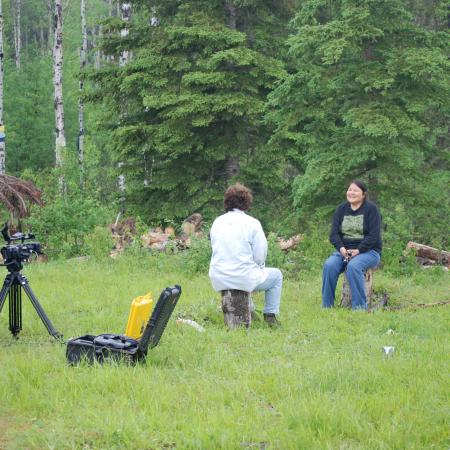
Notre peuple croit que notre responsabilité de prendre soin de la terre nous vient du Créateur.
Nous vivons toujours selon les connaissances et la sagesse qui nous ont été transmises par nos ancêtres.
C'est de la terre que nous tirons notre vie, notre sagesse et nos connaissances. Nous croyons fermement que la terre est très vivante et que nous devons reconnaître sa vie et sa spiritualité. La reconnaissance de la spiritualité de la terre soutient la santé de notre peuple et nous rappelle que nous sommes inséparables de la terre. L'un ne peut survivre sans l'autre.
Ce savoir a été transmis par l'histoire orale et il nous incombe de veiller à ce que nos connaissances et notre sagesse soient transmises à la prochaine génération.
En tant qu'Anishinaabeg, nous pensons que la terre ne nous appartient pas. Elle appartient aux générations futures ; nous devons donc réfléchir très attentivement à la manière dont les décisions que nous prenons aujourd'hui affecteront les nombreuses générations à venir.
Les enseignements contenus dans nos plans de gestion des terres sont très anciens. Les plans sont des documents vivants qui transmettent ces enseignements à la génération suivante.
Notre peuple pratique l'aménagement du territoire depuis des milliers d'années. Ils n'ont jamais laissé de traces de destruction ni provoqué l'extinction d'aucune espèce. Nous savions que notre survie dépendait de notre terre.
Aujourd'hui, nous reconnaissons à quel point nos terres et nos enseignements sont importants pour nous. En tant que peuple anishinaabe, nous avons subi les effets de la colonisation et de l'assimilation. Nous avons compris nos aînés qui nous ont dit que pour guérir, nous devions retourner à la terre pour rétablir l'équilibre au sein de notre communauté. Nous devons enseigner à nos jeunes - nos enfants et nos petits-enfants - l'importance de la relation sacrée que notre peuple entretient avec la terre. Ils doivent comprendre le lien spirituel que notre peuple entretient avec la terre et la vie qui nous entoure.
Tout ce que nos ancêtres utilisaient de la terre était traité avec respect, ce qui est pour moi la véritable définition de l'aménagement du territoire. Nos croyances spirituelles doivent être reconnues et incluses dans tout ce que nous faisons en tant qu'Anishinaabeg (Sophia Rabliauskas, 2015, membre de la communauté de la Première nation de Poplar River).

